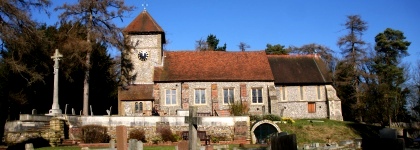


ST GILES ORGAN
A project to rebuild and modernise the organ at St.Giles was started in January 2019, with an expectation that it would be finished in time for Easter. This turned out to be very optimistic. A number of difficulties were encountered along the way, and the work was not completed fully until toward the end of the year. A period of settling in then started and this was still underway when Covid19 hit. Use of the organ had to be suspended, together with the opportunity to complete the fine tuning.
The project was managed by our Organist Clive Brearley, and he produced a number of progress reports while the work was underway. These were published on this website during 2019. Now that all is complete, Clive has gone on to prepare a comprehensive description and history of the organ, drawing on material written by past organists.
 |
 |
 |
The full document is available as a download here Download full History (pdf),
Here is the introduction to set the scene.
Introduction
Little about the St. Giles organs seems to have been documented in the past. On occasions when considerable expense has been involved little is recorded concerning how it all happened and there are a couple of occasions when lesser works were carried out but the only thing we have recording it is a brass plate on the wall. As a church organ is usually the most expensive single item in a church building this seemed a bit of a shame so I have tried to bring together everything that we know, adding in a few things that we don't know but can take a fairly good guess at and make it into some sort of a record. There would have been far wider gaps and (even more) inaccuracies had it not been for the help of John Wade, who was assistant organist at St. Giles in the 1960s. Most of the history of the organ up to 1963 is his work and the guesses are mine.When organists discuss what to do about an organ project the conversation quickly degenerates to jargon. Pneumatics, power motors, sliderless soundboards, 'bad breaks in yer mixture', reversible pistons, Swell engines, ODs, mounted cornets, stop solenoids, mutations, beards, open foot, closed foot, nicking..........the list is endless. The terminology has built up over many years and is very handy if you want to blind people with science. The eyes of the clergy, treasurers, PCC members and congregation glaze over quickly, they give up trying to understand and leave it to the organist to argue the toss with organ builders, Diocesan representatives etc. Of course, organists just might be more keen on satisfying their ego rather than putting the needs of the church first and sometimes get away with having expensive work done that suits them but not necessarily the needs of the Parish. Organists have in the past sometimes been attracted to playing the organ due the amount of noise they can make and the complex mechanisms but things have changed: plenty of other opportunities for playing around with technology have emerged through the years and now organists tend to be much more interested in craftsmanship and artistry and making a musical sound. It is something of a challenge to be involved with a project like the St. Giles organ. There are so many reasons why perfection will not be achieved. But no organ is perfect.
Whilst what follows is primarily for record purposes and, while I have tried to make it readable, some of it will probably seem a bit 'dry' to non-organists. I hope that those who are interested in what has been done through the years will want to read it all. In an attempt to facilitate this, where I have used terms that make no sense to the non-organist and not explained them in the text I have included them in a sort of glossary of jargon at the end in the hope that non-organists can get some idea of what I'm on about. I have tried not to make this too involved so there are generalisations and by no means every term is explained. The terms included in the glossary are shown in the text in Italics. I have also included a bit about the role of the organ in the Anglican Church through the years in an attempt to give a background to why things happened when they did and to put things into perspective.
Improving the Louder Bits (2022)!
Every organ is different. Each one has to suit different buildings,
acoustics and musical requirements. No organ could be described as
perfect. In the 2019 re-build of the St. Giles Organ, we managed to
achieve the things we needed to do to make it as good as it could be for
our present needs – except for one thing. One rank of pipes, a Trumpet
stop, which was not of the best quality and made a horrid sound
(certainly sounding nothing like a trumpet) was re-voiced by a
specialist to attempt to make a different, 'smoother' sound – known as a
Cornopean stop. The result was disappointing and not much better than
before. We had, to put it in laymen's terms, asked for silk purses to be
made out of sows' ears that were not even big enough to make that size
of purse. It was not really useable. One Saturday night last January an organist friend of mine rang to say that he was helping to dismantle an organ in a redundant United Reformed church in Epsom and it contained a rank of pipes that might make a good replacement. so off I went to get them and put them into storage, handing over a contribution equivalent to the scrap value. I cannot say that I have ever seen better made organ pipes. Made of quite heavy gauge ‘spotted metal' (an alloy sometimes known as organ builders' metal, a mixture of lead and at least 45% tin), they looked as if they might indeed be the answer. I reckon that they would have cost more than £12K to have made today. Off to St. Giles I went with a few of the pipes to meet up with Phil the tuner who tried putting them into the organ to try them out. They sounded good so I asked for a price for cleaning them, regulating and installing, expecting it to cost around £350.
The quotation arrived - £2500 + VAT! More alteration needed to be made to soundboards, rack boards etc. than I had hoped. I was delighted when the PCC agreed to the expenditure. It was felt that having spent so much money on the organ re-building it would be the right thing to do in order to complete the project. So, I delivered the pipes to the organ builder's brand-new works outside Canterbury, which I must say is rather more impressive than the old works which was in an old village school that was falling down, with instructions that the pipes needed to be set up properly on their voicing machine to confirm that all was in order before doing alterations to the organ itself.
In early August work commenced in church. Not everything had been done in the works in the way I had specified and a couple of shirty emails later (through the years I have become an absolute expert in writing shirty emails to organ builders) another day was spent by them in church putting right what should have been done properly before they started. I have included a photo of what one of the new pipes looks like. They are a bit odd looking; you might feel! Organ pipes are divided into two groups: flue pipes (the sort you see on the front of the St. Giles organ which function in the same way as a whistle) and reed pipes like this one, which produce their sound in the same way as an orchestral reed instrument such as a clarinet. Because of the slightly unusual way in which the new pipes are made we knew not only who made them and when but that they would make the sort of sound we were looking for. The pipes that they replaced were not particularly well made and included a few oddments.
Organs really hate the sort of weather we have had this summer and it tends to make them go out of tune. So, after a month or so settling in, the 'new' pipework had its final regulation and tuning towards the end of September. I'm personally over the moon that what was really bugging me is now resolved and really works well but what is far more important is the Parish's commitment to the future of music at St. Giles. A contribution of £1250 (half the cost) has generously been donated by the Friends of St. Giles and we are very grateful to The Friends Committee and its members for this grant.
Clive Brearley